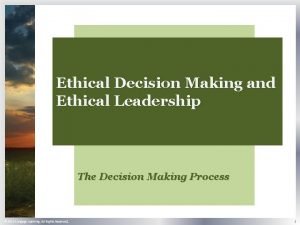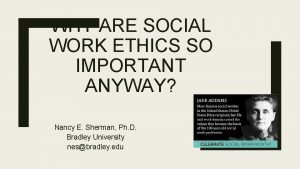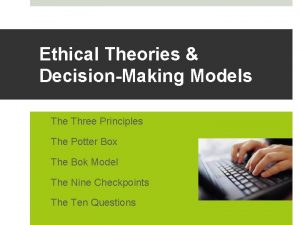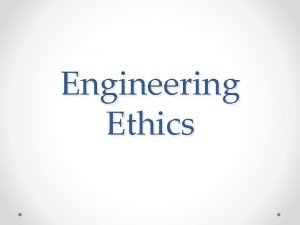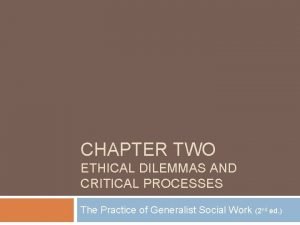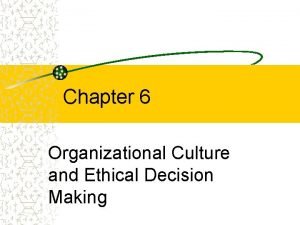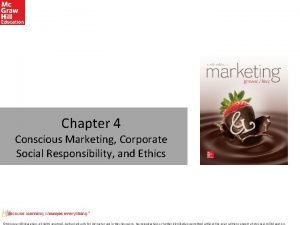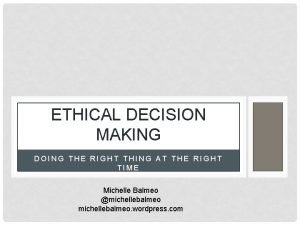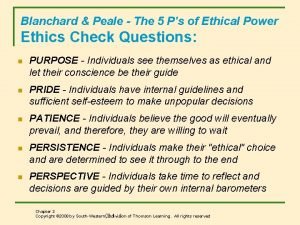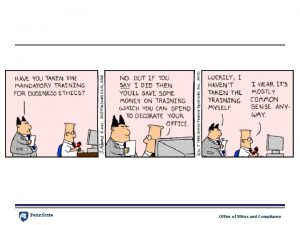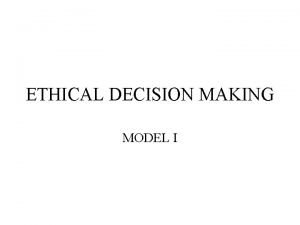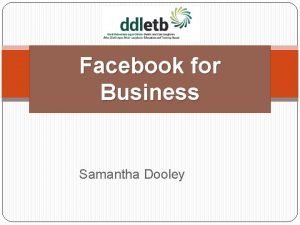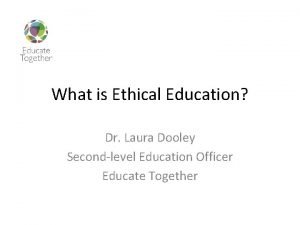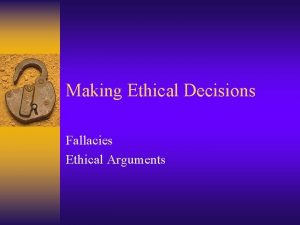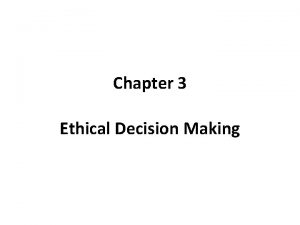Ethical Decision Making Dr Laura Dooley Secondlevel Education
















- Slides: 16

+ Ethical Decision Making Dr. Laura Dooley Second-level Education Officer Educate Together

+ Can lying be justified? 1. Do you agree? 2. How did you make your decision- what factors did you consider? (Note these for later and relate to ethical decision making approaches) 3. What has influenced this decision making- prior experience, upbringing, religion, family, values etc. ? 4. Does everyone agree? Would considering another viewpoint change your opinion?

+ What is Ethics? n Ethics refers to standards of behavior that tell us how human beings ought to act in the many situations in which they find themselves. What Ethics is not: n Feelings n Religion n The Law n Science n Following culturally accepted norms

+ 5 Approaches to Ethical Decision Making 1. The Utilitarian Approach 2. The Rights Approach 3. The Fairness or Justice Approach 4. The Common-Good Approach 5. The Virtue Approach

+ Utilitarian Approach Utilitarianism was conceived in the 19 th century by Jeremy Bentham and John Stuart Mill to help legislators determine which laws were morally best. Both Bentham and Mill suggested that ethical actions are those that provide the greatest balance of good over evil. 1. Identify the various courses of action available to us. 2. Ask who will be affected by each action and what benefits or harms will be derived from each. 3. Choose the action that will produce the greatest benefits and the least harm. Ø The ethical action is the one that provides the greatest good for the greatest number.

+ Rights Approach This approach to ethics has its roots in the philosophy of the 18 thcentury thinker Immanuel Kant and others like him, who focused on the individual's right to choose for herself or himself. According to these philosophers, what makes human beings different from mere things is that people have dignity based on their ability to choose freely what they will do with their lives, and they have a fundamental moral right to have these choices respected. People are not objects to be manipulated; it is a violation of human dignity to use people in ways they do not freely choose. • Ask does the action respect the moral rights of everyone? Ø Actions are wrong to the extent that they violate the rights of individuals; the more serious the violation, the more wrongful the action.

+ Fairness or Justice Approach The fairness or justice approach to ethics has its roots in the teachings of the ancient Greek philosopher Aristotle, who said that "equals should be treated equally and unequals unequally. ” • Ask how fair is an action? Does it treat everyone in the same way, or does it show favoritism and discrimination? Ø Favoritism gives benefits to some people without a justifiable reason for singling them out; discrimination imposes burdens on people who are no different from those on whom burdens are not imposed. Both favoritism and discrimination are unjust and wrong.

+ Common-Good Approach The common good is a notion that originated more than 2, 000 years ago in the writings of Plato, Aristotle, and Cicero. In this approach, we focus on ensuring that the social policies, social systems, institutions, and environments on which we depend are beneficial to all. Examples of goods common to all include affordable health care, effective public safety, peace among nations, a just legal system, and an unpolluted environment. n Reflect on broad questions concerning the kind of society we want to become and how we are to achieve that society. Ø Appeals to the common good urge us to view ourselves as members of the same community, . While respecting and valuing the freedom of individuals to pursue their own goals, the common-good approach challenges us also to recognize and further those goals we share in common.

+ Virtue Approach The virtue approach to ethics assumes that there are certain ideals toward which we should strive, which provide for the full development of our humanity. These ideals are discovered through thoughtful reflection on what kind of people we have the potential to become. Honesty, courage, compassion, generosity, fidelity, integrity, fairness, self-control, and prudence are all examples of virtues. n Ask what kind of person should I be? What will promote the development of character within myself and my community? Ø A person who has developed virtues will be naturally disposed to act in ways consistent with moral principles. The virtuous person is the ethical person.

+ Ethical Problem Solving These five approaches suggest that once we have ascertained the facts, we should ask ourselves five questions when trying to resolve a moral issue: 1. What benefits and what harms will each course of action produce, and which alternative will lead to the best overall consequences? 2. What moral rights do the affected parties have, and which course of action best respects those rights? 3. Which course of action treats everyone the same, except where there is a morally justifiable reason not to, and does not show favoritism or discrimination? 4. Which course of action advances the common good? 5. Which course of action develops moral virtues?

+ A pregnant woman leading a group of people out of a cave on a coast is stuck in the mouth of that cave. In a short time high tide will be upon them, and unless she is unstuck, they will all be drowned except the woman, whose head is out of the cave. Fortunately, (or unfortunately, ) someone has with him a stick of dynamite. There seems no way to get the pregnant woman loose without using the dynamite which will inevitably kill her; but if they do not use it everyone will drown. What should they do?

+ 40 years from now, you have gone into politics and become the Minister for Health. During this time, medical advances have made transplant surgery very successful, so that from one healthy body at least five lives can be saved. But improvements in car safety have also meant that fewer people are dying in accidents, so there is a shortage of donor organs. A proposal from MI 13 comes across your desk. They have a plan to “disappear” healthy people who have no friends or family, so that the organs of each one can be harvested to save five lives.

+ Two men are travelling in the desert. They have only one bottle of water between them. If they share it, they will both die. If one drinks the water, he will survive, but his companion will not. What are they to do? One view holds that they should share their water, so that neither will witness the death of his fellow. Another view argues that the owner of the bottle, who had the foresight to bring it, should drink the water. We have two contradictory interpretations. How are we to consider the divergent views? Whose life takes precedence? What if one traveller is a child and the other an adult? What if the travellers are a man and a woman? How do we measure the value of life?

+ What’s your favourite film? n What is the main storyline? n Who are the main characters? n Why is this your favourite film? n Do you think it would be suitable to use in the classroom? Why? /Why not?

+ Bechdel Test n Developed by Allison Bechdel in her comic strip Dykes to Watch Out For in 1985 n http: //feministfrequency. com/2009/12/07/the-bechdel-test-forwomen-in-movies/ n http: //dykestowatchoutfor. com/wp-content/uploads/2014/05/The -Rule-cleaned-up. jpg n Does your favourite film pass the Bechdel test?

+ Should we all be feminists? n http: //www. singjupost. com/we-should-all-be-feminists-bychimamanda-ngozi-adichie-full-transcript/
 The perceived relevance or importance of an ethical issue
The perceived relevance or importance of an ethical issue Ethical dilemma in social work
Ethical dilemma in social work Ends based thinking
Ends based thinking 7 steps model for ethical decision making
7 steps model for ethical decision making Ethical principles screen
Ethical principles screen The role of corporate culture in ethical decision making
The role of corporate culture in ethical decision making Understanding how csr differs from conscious marketing
Understanding how csr differs from conscious marketing 7 step ethical decision making model
7 step ethical decision making model Kerridge's decision making model
Kerridge's decision making model Potter's box for ethical decision making
Potter's box for ethical decision making Blanchard and peale
Blanchard and peale Ethical decision making
Ethical decision making Credo leadership behaviors
Credo leadership behaviors Introduction to ethical decision making
Introduction to ethical decision making No decision snap decision responsible decision
No decision snap decision responsible decision Financial decision
Financial decision Samantha dooley
Samantha dooley
